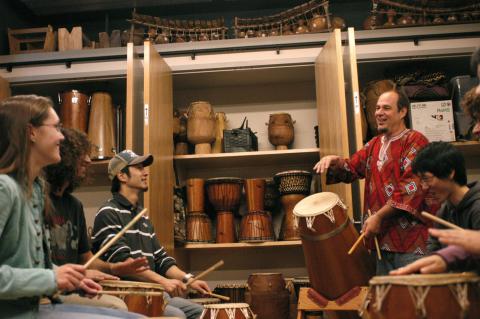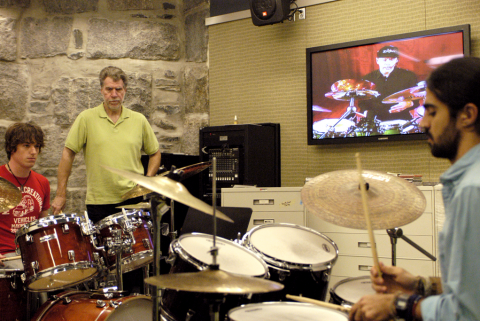Percussion Facilities Get a Facelift
When heavy rains fell in the Boston area during the fall of 2005, many around the Bay State experienced flooding problems, including Berklee. The basement of the 1140 Boylston Street building, home of the Percussion Department for years, was flooded by water from the city’s overwhelmed storm drains that came into the building from the alley off Hemenway Street. Water also seeped in from broken lines that ran below the basement floor and the streets outside.
“It was a real mess,” says John Eldert, Berklee’s vice president for administration. “The basement became so humid that mold began developing behind the walls, under the floors, and in the closets. President Brown supported the decision to immediately shut the whole floor down and undertake renovations to solve all of the problems.”

Associate Professor Joe Galeota (standing) works with a percussion ensemble in his African percussion room.
Through the cooperation and understanding of faculty members, students, staff members, and others college-wide, all Percussion Department faculty offices, teaching studios, and ensemble rooms were moved to new locations until the year of reconstruction work was completed.
The college contracted Miller Dyer Spears, an architectural firm involved in previous college renovations, to create a fast-track design. Shawmut Design and Construction did the building. At the conclusion of the project, Shawmut officials said that the job was the company’s most difficult one last year. The work entailed removing the entire concrete slab floor, replacing rusted support beams, rebuilding an elevator, repiping all water and sewer lines, and overhauling the electrical system. Nonetheless, the job was finished on schedule and according to specifications.
The result: a dramatically improved percussion facility that is completely up to date and visually appealing. Faculty members are thrilled with the acoustics as well. “There was a lot of thought given to the acoustics,” says Eldert. “Each of the separate rooms is actually an independent box with its own concrete slab floor and an independent ceiling above. Sound-absorbent panels were placed on the walls and ceilings, and each room can be tuned acoustically.”

Professor Skip Hadden (background) teaches drummers in his new teaching studio. Note the exposed granite wall in the background.
A bonus of removing the old concrete walls was the exposure of large granite blocks that form the building’s foundation. The blocks have been treated with waterproofing and are now exposed, which adds to the visual appeal and acoustic properties of the rooms.
“The Percussion Department renovation was designed to accommodate the educational needs of our students,” says Percussion Department Chair Dean Anderson. “The larger spaces will provide the proper setting for the students to succeed in their learning experience. In addition, the acoustics and storage capability of this new space are terrific upgrades from the previous facilities.”




